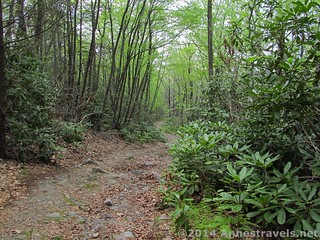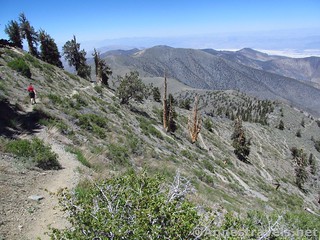
This site uses Shenandoah National Park’s system for determining a trail’s difficulty. The difficulty is determined by a combination of length and elevation gain with consideration taken for especially rugged terrain (for example, rock scrambles are more difficult than a paved path of the same length/elevation gain).
However, as I used this system of arranging trail difficulty, I found that it wasn’t very accurate in terms of comparing trails. An “easy” hike could range from a 0.1 mile trail on a paved path to an 8 mile trail with only 150ft. of elevation gain. You might have two supposedly “moderate” trails that were actually very different in terms of length and actual difficulty. To rectify this, I put together a second difficulty system: Trails that were 0-5 miles in length and trails that were 5+ miles in length. Sometimes I’ll also use a 10+ milage rating system to help compare trails of similar lengths. Every hike on this site has both the overall difficulty rating and a second difficulty rating within its mileage class. I hope this makes your life easier when trying to compare and choose trails based on difficulty! Trail color on maps reflects the hike’s overall difficulty, not its 0-5 or 5+ mile difficulty.
Easy Trails (Green on maps)
An easy hike is typically short with easier tread. The trail is frequently level or has small inclines. Scrambling is rarely required, although there may be sections of slickrock.

Moderate Trails (Blue on maps)
Moderate trails may be longer or have rougher or steeper terrain. They are still suitable for novice hikers who want a bit of a challenge. Light scrambling (usually Class 2 or less) may be required on some trails.

Moderately Strenuous Trails (Yellow on maps)
Trails that are moderately strenuous will be challenging for a novice hiker. Grades may be steeper, the terrain rougher, or the mileage longer. Light scrambling (usually no more than Class 2) may be required on some trails.

Strenuous Trails (Red on maps)
Strenuous trails are longer, steeper, and offer a good challenge. Scrambling up to Class 3 may be required.

Very Strenuous Trails (Orange on maps)
You may begin to question your sanity on a very strenuous trail, especially if you haven’t hiked in a while. Very strenuous trails tend to be very long or have extreme elevation change; scrambling up to a Class 4 could be encountered.

Extremely Strenuous Trails (Purple on maps)
Even experienced hikers will find themselves on the masochist honor roll after acing an Extremely Strenuous Trail. Scrambles up to Class 4, extreme elevation change, and exceedingly long trails are to be expected here.

Very Extremely Strenuous Trails (Purple on maps)
Just why are you doing this to yourself??? A Very Extremely Strenuous Trail is beyond the abilities of all but the most dedicated, possibly insane hikers. Crazy Class 4 scrambles, insane mileages, and elevation gains in the 3,000+ft. are the going fare on these hikes.

How I Determine Trail Difficulty:
This may become a technical discussion. Because it uses math. It even uses square roots (gasp!)
To determine a trail’s difficulty rating, we use the following formula:
(Elevation gain in feet) x 2 x (distance in miles). Take the square root of the resulting number and then use the following chart to determine the trail’s difficulty rating:
Overall Difficulty:
<49 = Easy
50-99 = Moderate
100-149 = Moderately Strenuous
150-199 = Strenuous
200-249 = Very Strenuous
250-300 = Extremely Strenuous
300+ = Very Extremely Strenuous
0-5 Mile Difficulty:
<24 = Easy
25-49 = Moderate
50-74 = Moderately Strenuous
75-99 = Strenuous
100-124 = Very Strenuous
125-149 = Extremely Strenuous
150+ = Very Extremely Strenuous
5+ Mile Difficulty:
<24 = Easy
25-74 = Moderate
75-124 = Moderately Strenuous
125-174= Strenuous
175-224 = Very Strenuous
225-274 = Extremely Strenuous
275+ = Very Extremely Strenuous
10+ Mile Difficulty:
<74 = Easy
75-124 = Moderate
125-199 = Moderately Strenuous
200-249= Strenuous
250-299 = Very Strenuous
300-349 = Extremely Strenuous
350+ = Very Extremely Strenuous
Example 1: The Fall Canyon Trail in Death Valley National Park is 6.6 miles long with 1,839ft. elevation gain. Put it in the formula, you get (1,839) x 2 x (6.6) = 24,274.8. Take the square root of that and you get 155.8, which rounds to 156. In the overall difficulty rating, this just dips over the line in the Strenuous category. For the 5+ mile rating, 156 is a very solid Strenuous.
Example 2: The Lost Canyon Trail in Canyonlands National Park is 4.6 miles long with 896ft. elevation gain. Our formula is (896) x 2 x (4.6) = 8,243.2; take the square root and you get 90.7, which rounds to 91. The overall difficulty rating for Lost Canyon is on the higher end of Moderate. In the 0-5 mile difficulty rating, Lost Canyon comes out as Strenuous. This tells us that while Lost Canyon isn’t an overly difficult trail, it is more difficult than other short trails.
Feel free to put my numbers into the formula to find the difficulties on your own!
Thanks to Shenandoah National Park for their trail difficulty formula! You can see their writeup about it at: https://www.nps.gov/shen/planyourvisit/how-to-determine-hiking-difficulty.htm